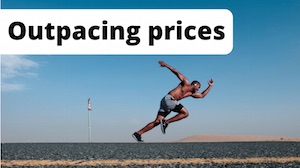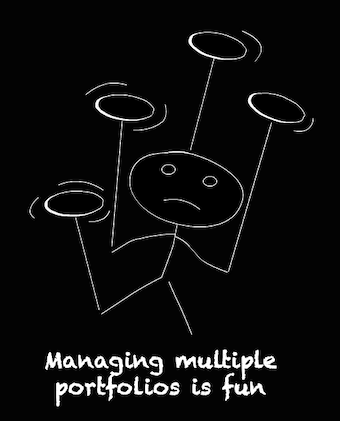This article exploring dogs and financial independence is by The Mr & Mrs from Team Monevator. Check back every Monday for more fresh perspectives on personal finance and investing from the Team.
When The Mr & Mrs moved out of London, top of my – The Mrs – agenda was getting a dog. My husband and the youngest child were less keen.
My childhood memories centred on rural adventures accompanied by various dogs – all long gone now to the Great Kennel in the Sky.
The Mr grew up in a pet-free house on a busy city road.
The Mr: Actually we had cats for a time, but I don’t talk about them. They weren’t as much part of our childhood. Cats aren’t part of the family like dogs. And we got fed up with them being injured or worse on the road.
“Dogs are like toddlers,” I tell The Mr, setting back Project Dog by 18 months. (Both of us had endured our kids’ pre-school years in a blur of exhaustion.)
Dogs are also more expensive than back when I paid £35 for my first dog, aided and abetted by my mother.
I’d washed cars, weeded gardens, and sold homemade biscuits. I’d diligently coloured in each pound I earned on a ‘sweat’ chart. And, for every £5 I raised, my parents pledged to buy a piece of essential kit starting with the feeding bowl and culminating in a dog bed.
Enter Show Dog
My first dog – hereafter called ‘Show Dog’ – set a high standard. I chose her from a squealing litter of pups and, unwittingly, picked a champion.
This is roughly akin to a rookie investor picking Tesla shares in mid-2019 on the basis that they liked the company name.
It didn’t take long for my mother to realise my pedigree pooch was a perfect specimen of her breed – or that serious money could be won at dog shows.
Our weekend routine changed as I learned some simple cost-benefit analysis featuring:
- The type of show, number of classes for which Show Dog was eligible, and total entry fees payable.
- The unit price of petrol, a guesstimate of mileage and travelling time, and the allocations of prize money.
- The random element – the judge. Show Dog was the blackest black and was unlikely to be highly-placed by a judge known to prefer blondes…
There were highs – seven rosettes in one show!
And there were lows, such as the time Show Dog refused all instruction at a Very Important Event, careered around the ring, and leapt up to kiss the judge’s nose.
We drove home in silence, brooding on the financial hit.
Positive financial returns
Training, showing, and breeding dogs was not my family’s livelihood.
(If you are interested in showing your dog or other competitive activities like agility or flyball, then Crufts’ resources are a good place to start.)
No, Show Dog’s success was unusual; she was a child’s pet. Show Dog was fuss-free (no clipping required) and barely saw the vet.
Her winnings paid for her keep. Her two litters of pups covered their costs with extra to spare. One puppy even had a lucrative turn as a ‘moveable prop’ in a big-budget Hollywood film.
Overall verdict: Over her lifetime, Show Dog made a small net financial contribution of approximately £200 to the family income.
Beware of the Diva Dog
Not every dog is as cost-effective as Show Dog turned out to be. In contrast, the dog I chose as The Mr and Mrs’ first family pet – Diva Dog – has been a constant drain on the family coffers.
Diva Dog confirmed all The Mr’s misgivings about mixing dogs and financial independence.
From her puppyhood, Diva Dog was charged with three strategic objectives:
- Train the whole family in handling dogs. Specifically, cure the youngest child of a crippling fear of dogs. (A drastic solution, I know. There’s good advice at Dogs Trust.)
- Create positive family memories and act as a canine counsellor for the children at stressful points in their lives, like exams or friendship fall-outs.
- Assist in the family’s fitness regime. Model good health, and rarely trouble the vet.
In fairness, Diva Dog excelled in the first two tasks.
However, my Midas touch deserted me when choosing Diva Dog from her siblings. Instead of spotting championship potential, this time I paid £850 for what was probably the runt of the litter (and during lockdown prices have risen substantially since then, too).
The Mr: We paid how much?!
Diva Dog is much smaller than her breed standard. She has long fur and panics at any loud noise, despite coming from working gundog stock (though she does love a karaoke party).
Diva Dog is an expert counter-surfer and pavement-snacker. No food is safe from her snout.
And here’s the rub: Diva Dog is hyper-allergic to almost everything, especially commercial dog foods. So Diva Dog’s endless scavenging means she is on first name terms with all the vets and nurses at our local practice.
Start-up costs: purchase, vaccines, essential dog kit, micro-chipping and basic obedience classes – around £1,400 (in 2013 money)
Ongoing costs: specialist food, standard (wormers, flea and tick) and prescribed medicines for ear/skin flare ups; kennels or holiday pet insurance; general pet insurance, replacement toys, and so on. In 2020, Diva Dog cost almost £1,700.
Overall verdict: Diva Dog is a financial liability!
Owning a dog is a lottery
Show Dog and Diva Dog are financial outliers. Most pet dogs will fall somewhere in the middle. Lifetime costs can vary wildly, even between dogs of a similar age, size, and breed.
You might re-home a rescue puppy that needs behavioural help. You might choose a retired working dog that arrives fully trained but gets increasingly expensive to insure. Or you might experience a change in your circumstances and need to pay for daily dog walking for your pet.
But the real cost of dog ownership lies not in money. It’s measured in time.
The time factor
When people say they’d love a dog but can’t afford one, what they usually mean is they don’t have the time.
And, if you lack time, then owning a dog – with or without a quest for financial independence – is not for you.
Dogs are social creatures. While some dogs may be shy introverts, most want to be with you, at the centre of things. No dog wants to be left in solitary confinement all day, every day. The general consensus is that four hours during the daytime is the maximum length of time to leave a dog on its own.
The Mr: For me, the key is that they are part of the family. Consider your dogs in all decisions, just like you would any other family member.
For most people on the path to FI, it’s less a question of having enough money for a dog, and more about existing and future time commitments.
Perhaps you work from home and choose to slow down? You sacrifice a year or two to reaching your FI number in exchange for canine companionship on the path to financial freedom.
Or maybe your FI strategy is to work long hours, create a dog-budgeted savings goal, and then to look forward to early retirement.
Either way, know there are ways to get a dog-fix without the need for potentially expensive ownership. For ideas, take a look at Walk My Dog, Cinnamon Trust, or guide dog fostering.
In praise of dogs
If dogs are expensive and eat into all your available time, then why own one?
It’s certainly a mystery to friends who are happily dog-free.
As I type this blog, Diva Dog is snortling in her basket – a reassuring sound – and The Young ‘Un is keeping my feet warm.
My dogs will get restless if I sit still for too long so I have no need of a Fitbit, Apple Watch, or timer.
There’s less need to pay for exercise classes. Every day in all weathers I’m out with the dogs. And dog walkers are a sociable crowd, even at 6am.
Whenever somebody or something is outside of our house I have an early warning system.
I am no longer susceptible to fast fashion. There’s no point wasting money on strappy shoes or silk dresses when I’m mostly wading through puddles.
Finally, I have canine companions who are quick to tune into emotional moods. They snuggle up when they sense you are sad and become playful when they can tell you are happy.
The Mr: This last one is literally priceless!
Dogs and financial independence
Here are a few top tips if you’re still interested in owning a dog.
Research, research, research
Assess your lifestyle honestly and choose a dog breed that’s a good fit. Even if you want a rescue dog of uncertain parentage, different breeds have different behavioural traits. Check out the Kennel Club’s databases. Also try Crufts Meet the Breed, once this sort of thing restarts.
Shun the puppy farm
Always get your dog from a reputable source, whether it’s a friend whose dog has puppies, a rescue centre, or a Kennel Club Assured Breeder. This will also minimise your risk of buying a stolen dog. Ideally you will see the mother, if buying a pup. Expect the breeder or rescue centre to ask you searching questions about your ability to keep a dog!
Dogs are valuable
Make sure your garden boundaries are escape-proof. Periodically recheck them. Crawl around your rooms to discover what a dog – especially a teething puppy – might find interesting. Microchip your dog, and attach a collar tag with just your mobile or landline details. Don’t skimp on vaccinations.
Invest in training
Basic training at village halls can be crowded, noisy, and confusing for you and your dog. It can pay dividends to have a trainer come to your home, especially if you have never owned a dog before or several family members are giving the dog different commands. Classes can bore clever dogs. Taking them to flyball, agility, or similar sessions will be fun, while sneakily improving overall obedience.
Don’t shop around on insurance
If you have pet insurance and have made any claims, resist the temptation to shop around for a cheaper renewal. Insurers will not cover preexisting conditions, so you may end up paying for any ongoing ones on top of your insurance. It’s galling to see the premiums mount up each year, but there it is. And of course as your dog gets older they will be more expensive to cover. You can self-insure if you are very disciplined. Set aside what you would have paid on insurance each month and use that to cover vet bills.
Be patient
It takes time to gain a dog’s trust and loyalty. Be kind. Be consistent. Look forward to seeing a happy wagging tail each morning!
Owning a dog may prolong your journey to financial independence. But what matters most is being judicious about what you sacrifice, rather than giving up everything you want along the way.
In The Mr & Mrs’ household, our dogs and financial independence have – on balance – been reconciled. The dogs help us stay on the path to financial independence. Because we are all in it together.
In time you will be able to see all The Mr & Mrs’ articles in their dedicated archive.








